Chernobyl Nuclear Power Plant
The Chernobyl Nuclear Power Plant (officially, the Vladimir Ilyich Lenin Nuclear Power Plant) is a closed nuclear power plant near the abandoned city of Pripyat in northern Ukraine, 16.5 kilometers (10 mi) northwest of the city of Chernobyl, 16 kilometers (10 mi) from the Belarus–Ukraine border, and about 100 kilometers (62 mi) north of Kiev. It was cooled by an engineered pond, which is fed by the Pripyat river about 5km northwest from its juncture with the Dnieper river.
| Chernobyl nuclear power plant | |
|---|---|
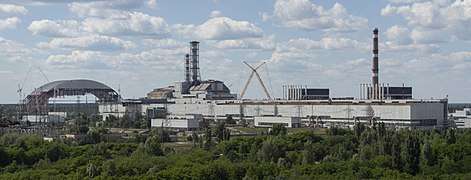 View of power plant in 2013. From L to R New Safe Confinement under construction and reactors 4 to 1. | |

| |
| Official name | Vladimir Ilyich Lenin Nuclear Power Plant |
| Country | Ukraine |
| Location | Pripyat |
| Coordinates | 51°23′21″N 30°05′58″E |
| Status | Inactive |
| Construction began | August 15, 1972 |
| Commission date | September 26, 1977 |
| Decommission date | Process ongoing since 2000 |
| Operator(s) | SAUEZM |
| Nuclear power station | |
| Reactors | 4 |
| Reactor type | RBMK-1000 |
| Thermal capacity | 12,800 MW |
| Power generation | |
| Units operational | None |
| Nameplate capacity | 4,000 MW |
| External links | |
| Website | chnpp |
| Commons | Related media on Commons |
Reactor No. 4 was the site of the Chernobyl disaster in 1986, and the power plant is now within a large restricted area known as the Chernobyl Exclusion Zone. Both the zone and the former power plant are administered by the State Agency of Ukraine on Exclusion Zone Management. The three other reactors remained operational after the accident but were eventually shut down by 2000, although the plant remains in the process of decommissioning as of 2020. Nuclear clean-up is scheduled for completion in 2065.[1]
Construction
.jpg)
The nuclear power plant consisted of four RBMK-1000 reactors, each capable of producing 1,000 megawatts (MW) of electric power (3,200 MW of thermal power), and the four together produced about 10% of Ukraine's electricity at the time of the disaster.[2] Construction of the plant and the nearby city of Pripyat to house workers and their families began in 1970, with reactor No. 1 commissioned in 1977. It was the third Soviet RBMK nuclear power plant, after the Leningrad Nuclear Power Plant and the Kursk Nuclear Power Plant, and the first plant on Ukrainian soil.[3]
The completion of the first reactor in 1977 was followed by reactor No. 2 in 1978, No. 3 in 1981, and No. 4 in 1983. Two more blocks, numbered five and six, of more or less the same reactor design, were planned at a site roughly a kilometer from the contiguous buildings of the four older blocks. Reactor No. 5 was around 70% complete at the time of block 4's explosion and was scheduled to come online approximately six months later, on November 7, 1986. In the aftermath of the disaster, the construction on No. 5 and No. 6 were suspended, and eventually canceled in April 1989, just days before the third anniversary of the 1986 explosion.[4] Six other reactors were planned on the other side of the river. All 12 reactors would be planned to be running in 2010.
Reactors No. 3 and 4 were second generation units, whereas No. 1 and 2 were first-generation units, like those in operation at the Kursk power plant. Second-generation RBMK designs were fitted with a more secure containment structure visible in photos of the facility.[5]
Design
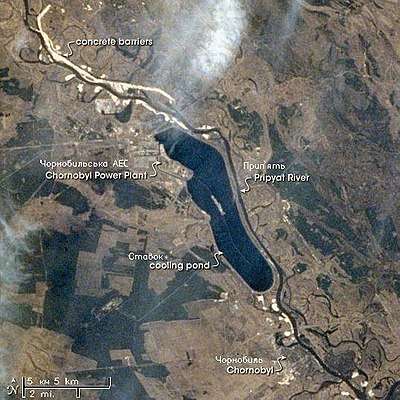
Electrical systems
The power plant is connected to the 330 kV and 750 kV electrical grid. The block has two electrical generators connected to the 750 kV grid by a single generator transformer. The generators are connected to their common transformer by two switches in series. Between them, the unit transformers are connected to supply power to the power plant's own systems; each generator can therefore be connected to the unit transformer to power the plant, or to the unit transformer and the generator transformer to also feed power to the grid.[6]
The 330 kV line was normally not used, and served as an external power supply, connected to a station's transformer – meaning to the power plant's electrical systems. The plant was powered by its own generators, or at any event got power from the 750 kV national grid through the main grid backup feed in transformer, or from the 330 kV level feed in grid transformer 2, or from the other power plant blocks via two reserve busbars. In case of total external power loss, the essential systems could be powered by diesel generators. Each unit's transformer is therefore connected to two 6 kV main powerline switchboards, A and B (e.g. 7A, 7B, 8A, 8B for generators 7 and 8), powering principal essential systems and connected to even another transformers at voltage 4 kV which is backed up twice (4 kV reserve busbar).[6]
The 7A, 7B, and 8B boards are also connected to the three essential power lines (for the coolant pumps), each also having its own diesel generator. In case of a coolant circuit failure with simultaneous loss of external power, the essential power can be supplied by the spinning down turbogenerators for about 45 to 50 seconds, during which time the diesel generators should start up. The generators were started automatically within 15 seconds at loss of off-site power.[6]
Turbo generators
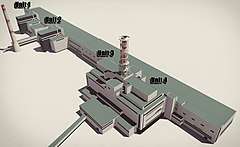
Electrical energy was generated by a pair of 500 MW hydrogen-cooled turbo generators. These are located in the 600 metres (1,969 ft)-long machine hall, adjacent to the reactor building. The turbines—the venerable five-cylinder K-500-65/3000—are supplied by the Kharkiv turbine plant; the electrical generators are the TBB-500. The turbine and the generator rotors are mounted on the same shaft; the combined weight of the rotors is almost 200 tonnes (220 short tons) and their speed is 3,000 revolutions per minute.[7]
The turbo generator is 39 m (128 ft) long and its total weight is 1,200 t (1,300 short tons). The coolant flow for each turbine is 82,880 t/h. The generator produces 20 kV 50 Hz AC power. The generator's stator is cooled by water while its rotor is cooled by hydrogen. The hydrogen for the generators is manufactured on-site by electrolysis.[7] The design and reliability of the turbines earned them the State Prize of Ukraine for 1979.
The Kharkiv turbine plant later developed a new version of the turbine, K-500-65/3000-2, in an attempt to reduce use of valuable metal. The Chernobyl plant was equipped with both types of turbines; block 4 had the newer ones. The newer turbines, however, turned out to be more sensitive to their operating parameters, and their bearings had frequent problems with vibrations.[8]
Reactor fleet

The construction of two partially completed reactors, No. 5 and 6, was suspended immediately after the accident at reactor No. 4, and was eventually cancelled in 1989.[9] Reactor No. 1 and 3 continued to operate after the disaster. Reactor No. 2 was permanently shut down in 1991 after a fire broke out due to a faulty switch in a turbine. Reactors No. 1 and 3 were eventually closed due to an agreement Ukraine made with the EU in 1995.
Ukraine agreed to close the remaining units in exchange for EU assistance in modernizing the shelter over reactor No. 4 and improving the energy sector of the country, including the completion of two new nuclear reactors, Khmelnitski 2 and Rovno 4. Reactor No. 1 was shut down in 1996 with No. 3 following in 2000.[10]
Computer systems
SKALA (Russian: СКАЛА, система контроля аппарата Ленинградской Атомной; sistema kontrolya apparata Leningradskoj Atomnoj, “Control system of the devices of the Leningrad Nuclear Power Plant”[11]) was the process computer for the RBMK nuclear reactor at the Chernobyl nuclear power plant prior to October 1995.[12] Dating back to the 1960s, it used magnetic core memory, magnetic tape data storage, and punched tape for loading software.
SKALA monitored and recorded reactor conditions and control board inputs. It was wired to accept 7200 analog signals and 6500 digital signals.[13] The system continuously monitored the plant and displayed this information to operators. Additionally, a program called PRIZMA (Russian: ПРИЗМА, программа измерения мощности аппарата; programma izmereniya moshchnosti apparata, “Device power measurement program”[11]) processed plant conditions and made recommendations to guide plant operators. This program took 5 to 10 minutes to run, and could not directly control the reactor.[14]
Known accidents and incidents
1982 reactor #1 partial meltdown
On September 9, 1982, a partial core meltdown occurred in reactor No. 1 as a result of a faulty cooling valve remaining closed following maintenance. Once the reactor came online, the uranium in the fuel channel overheated and ruptured. The extent of the damage was comparatively minor and no one was killed during the accident. However, due to the negligence of the operators the accident was not noticed until several hours later resulting in significant release of radiation in the form of fragments of uranium oxide and several other radioactive isotopes escaping with steam from the reactor via the ventilation stack. But the accident was not made public until several years later despite cleanups taking place in and around the power station and Pripyat. The reactor was repaired and put back into operation after eight months.
1986 reactor #4 catastrophe
.jpg)
On April 26, 1986, the Chernobyl disaster occurred at reactor No. 4, caused by a catastrophic power increase resulting in core explosions and open-air fires. This caused large quantities of radioactive materials and airborne isotopes to disperse in the atmosphere and surrounding land.
.jpg)
The disaster has been widely regarded as the worst accident in the history of nuclear power. As a result, Reactor No. 4 was completely destroyed, and therefore enclosed in a concrete and lead sarcophagus, followed more recently by a large steel confinement shelter, to prevent further escape of radioactivity. Large areas of Europe were affected by the accident. The radioactive cloud spread as far away as Norway.[15]
The plant utilized one large, open turbine hall for all four reactors without any separating walls. Each reactor had two turbines.
In February 2013, a 600 square metres (6,458 sq ft) portion of the roof and wall adjacent to the covered part of the turbine hall collapsed into the entombed area of the turbine hall. The collapse did not affect any other part of the Object Shelter or the New Safe Confinement. No variances in radiation levels as a result of the incident were detected.[16] The collapsed roof was built after the Chernobyl disaster, and was later repaired.[17]
1991 reactor #2 turbine fire
Reactor No. 2 was permanently shut down a little after October 1991 when a fire broke out due to a faulty switch in a turbine.[18]
On October 11, 1991, a fire broke out in the turbine hall of reactor No. 2.[19] The fire began in reactor No. 2's fourth turbine, while the turbine was being idled for repairs. A faulty switch caused a surge of current to the generator, igniting insulating material on some electrical wiring.[20] This subsequently led to hydrogen, used as a coolant in the synchronous generator, being leaked into the turbine hall "which apparently created the conditions for fire to start in the roof and for one of the trusses supporting the roof to collapse."[21] The adjacent reactor hall and reactor were unaffected, but due to the political climate it was decided to shut down this reactor permanently after this incident.
2017 cyberattack
The 2017 Petya cyberattack affected the radiation monitoring system and took down the power plant's official website which hosts information about the incident and the area.[22]
Decommissioning
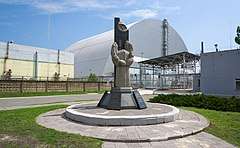
After the explosion at reactor No. 4, the remaining three reactors at the power plant continued to operate, as the Soviet Union could not afford to shut the plant down.[23] The schedule for plant decommissioning is intimately wrapped with the dismantling of reactor No. 4 and the decontamination of its environs. The Chernobyl New Safe Confinement will have equipment which will make decommissioning relatively incidental to, yet an integral part of, the cleanup of the exploded reactor. The majority of the external gamma radiation emissions at the site are from the isotope caesium-137, which has a half-life of 30.17 years. As of 2016, the radiation exposure from that radionuclide has declined by half since the 1986 accident.
In October 1991, reactor No. 2 caught fire, and was subsequently shut down.[18] Ukraine's 1991 independence from the Soviet Union generated further discussion on the Chernobyl topic, because the Verkhovna Rada, Ukraine's new parliament, was composed largely of young reformers. Discussions about the future of nuclear energy in Ukraine ultimately moved the government toward a decision to cancel the operation of reactor No. 2.
In November 1996, following pressure from foreign governments, reactor No. 1 was shut down.[24] Removal of uncontaminated equipment has begun at reactor No. 1 and this work could be complete by 2020–2022.[25] In December 2000, reactor No. 3 was shut down after operating briefly since March 1999[26], and the plant as a whole ceased producing electricity.[24] In April 2015, units 1 through 3 entered the decommissioning phase.[27]
In 2013, the pump lifting river water into the cooling reservoir adjacent to the facility was powered down, with the thermal sink, expected to slowly evaporate.[28]
Reactor No. 4
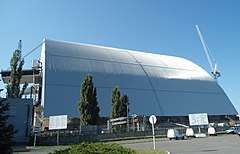
Originally announced in June 2003, a new steel containment structure named the New Safe Confinement was built to replace the aging and hastily built sarcophagus that protected reactor No. 4.[29] Though the project's development had been delayed several times, construction officially began in September 2010.[30] The New Safe Confinement was financed by an international fund managed by the European Bank for Reconstruction and Development and was designed and built by the French-led consortium Novarka.[31]
Novarka built a large arch-shaped structure out of steel, 270 meters (886 ft) wide, 100 meters (328 ft) high and 150 meters (492 ft) long to cover the old crumbling concrete dome that was in use at the time.[24] In November 2016, this new arch was placed over the existing sarcophagus.[32] This steel casing project was expected to cost $1.4 billion, and was completed in 2017. The casing also meets the definition of a nuclear entombment device.[33]
A separate deal has been made with the American firm Holtec International to build a storage facility within the exclusion zone for nuclear waste produced by Chernobyl.[34][35][36]
Footnotes
- "Chernobyl nuclear power plant site to be cleared by 2065". Kyiv Post. January 3, 2010. Archived from the original on October 5, 2012.
- library.thinkquest.org Archived May 4, 2009, at the Wayback Machine – All four of the reactors at the Chernobyl nuclear power station were of the RBMK-type
- "Chernobyl Timeline: How a Nuclear Accident Escalated to a Historic Disaster".
- "Soviets Cancel Plans for 2 New Reactors at Chernobyl". Los Angeles Times. Moscow. Times Wire Services. April 21, 1989. Archived from the original on June 27, 2019. Retrieved August 26, 2019.
The Soviet Union has canceled plans to construct two more reactors at the stricken Chernobyl nuclear power station...The decision was announced six days before the third anniversary of the accident at Chernobyl...
- "Early Soviet Reactors and EU Accession". World Nuclear Association. June 2019. Archived from the original on June 26, 2019. Retrieved March 10, 2016.
- British Nuclear Energy Society (1987). Chernobyl: a technical appraisal: proceedings of the seminar organized by the British Nuclear Energy Society held in London on 3 October 1986. London: Thomas Telford Ltd. ISBN 978-0-7277-0394-1. Retrieved June 27, 2010.
- "Energoatom Concern OJSC Smolensk NPP About the Plant Generation" (in Russian). Snpp.rosenergoatom.ru. April 30, 2008. Retrieved March 22, 2010.
- "Последняя командировка - Архив - Forum on pripyat.com". Forum.pripyat.com. Archived from the original on January 31, 2016. Retrieved March 22, 2010.
- International, From United Press (April 20, 1989). "Soviets Cancel New Reactors for Chernobyl". Retrieved April 1, 2018 – via LA Times.
- "Early Soviet Reactors and EU Accession - World Nuclear Association". www.world-nuclear.org. Retrieved April 1, 2018.
- "Что означают различные аббревиатуры и сокращения? - Сайт г. Припять. Чернобыльская авария. Фото Чернобыль. Чернобыльская катастрофа". pripyat.com. Archived from the original on January 18, 2019.
- "RBMK Reactors | reactor bolshoy moshchnosty kanalny | Positive void coefficient - World Nuclear Association". www.world-nuclear.org.
- State Committee for Using the Atomic Energy of USSR, THE ACCIDENT AT THE CHERNOBYL AES AND ITS CONSEQUENCES, Vienna, 25-29 August 1986.
- Howieson & Snell, Chernobyl - A Canadian Technical Perspective, January 1987 (PDF)
- Medvedev, Zhores A. (1990). The Legacy of Chernobyl (Paperback. First American edition published in 1990 ed.). W. W. Norton & Company. ISBN 978-0-393-30814-3.
- "Chernobyl radiation unaffected after heavy snow causes partial roof collapse, Ukrainian officials say". New York Daily press. Associated Press. February 13, 2013. Retrieved February 15, 2013.
- "Chernobyl roof collapses under snow". New Zealand Herald. AFP. February 14, 2013. Archived from the original on April 13, 2013. Retrieved February 15, 2013.
- "Backgrounder on Chernobyl Nuclear Power Plant Accident". US Nuclear Regulatory Commission. Retrieved January 16, 2011.
- "Fire Reported in Generator Area At the Chernobyl Nuclear Plant". The New York Times. October 12, 1991. Retrieved March 10, 2016.
- Roof fire at Chernobyl intensifies Ukrainian calls to close nuclear plant Baltimore Sun (October 13, 1991)
- Soviets Assure Safety at A-Plant Damaged by Fire New York Times (October 13, 1991)
- "Chernobyl's radiation monitoring system has been hit by the worldwide cyber attack". independent.co.uk. June 27, 2017. Retrieved April 1, 2018.
- Sarah Kramer, Business Insider; Apr 26, 2016. "Here's why Russia didn't shut down Chernobyl until 14 years after the disaster". Business Insider.CS1 maint: numeric names: authors list (link)
- Wil Mara (September 1, 2010). The Chernobyl Disaster: Legacy and Impact on the Future of Nuclear Energy. Marshall Cavendish. pp. 96–. ISBN 978-0-7614-4984-3.
- "Decommissioning at Chernobyl". Archived from the original on February 2, 2009. Retrieved March 10, 2016.
- "BBC News | Europe | Chernobyl reopens". news.bbc.co.uk.
- "Chernobyl 1-3 enter decommissioning phase". Retrieved March 10, 2016.
- "Draining the pond of the Chernobyl nuclear power plant". CHORNOBYL TOUR 2020 - trips to the Chornobyl exclusion zone, to the Pripyat town, ChNPP. (ex. CHERNOBYL TOUR).
- Yasuo Onishi; Oleg V. Voitsekhovich; Mark J. Zheleznyak (June 3, 2007). Chernobyl - What Have We Learned?: The Successes and Failures to Mitigate Water Contamination Over 20 Years. Springer Science & Business Media. pp. 247–. ISBN 978-1-4020-5349-8.
- Terra Pitta (August 5, 2015). Catastrophe: A Guide to World's Worst Industrial Disasters. Vij Books India Pvt Ltd. pp. 64–. ISBN 978-93-85505-17-1.
- Great Britain: Parliament: House of Commons: European Scrutiny Committee (March 1, 2011). Nineteenth report of session 2010-11: documents considered by the Committee on 16 February 2011, including the following recommendations for debate, reviewing the working time directive; global navigation satellite system; control of the Commission's implementing powers; recognition and enforcement of judgments in civil and commercial matters, report, together with formal minutes. The Stationery Office. pp. 59–. ISBN 978-0-215-55666-0.
- "Unique engineering feat concluded as Chernobyl arch has reached resting place". www.ebrd.com. Retrieved April 1, 2018.
- "NOVARKA and Chernobyl Project Management Unit confirm cost and time schedule for Chernobyl New Safe Confinement". European Bank. April 8, 2011. Retrieved April 22, 2012.
- "Chernobyl 25". Archived from the original on March 10, 2013. Retrieved March 10, 2016.
- Holtec International Press Release (December 31, 2007)
- "New licence for Chernobyl used fuel facility". World Nuclear News. March 28, 2013. Retrieved April 2, 2013.